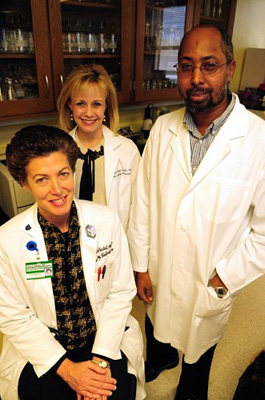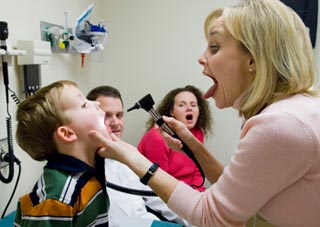
An infant’s risk of developing bronchiolitis caused by human rhinoviruses (HRV), aka the common cold, is linked to whether the mother has allergies or asthma, a new study by Kathryn Miller shows.
Miller has been adding to the body of evidence linking rhinoviruses with wheezing disease (bronchiolitis) and childhood asthma for a number of years.
In this latest work, published in the Journal of Allergy and Clinical Immunology, Miller and colleagues specifically examined HRV bronchiolitis in infancy and found having an atopic (allergic or asthmatic) mother doubles a baby’s risk.
“We found that these babies get sicker from rhinoviruses, but what we don’t know is whether these babies don’t handle HRV well perhaps because of some physiologic difference, or if HRV might in fact trigger wheezing disease in these predisposed children,” Miller said.
Of the 162 infants in Miller’s study confirmed to have an HRV infection through DNA testing called real-time reverse transcription-polymerase chain reaction, most had a head cold.
That was expected. But 18 percent had bronchiolitis, and a few cases were severe enough to require hospitalization.

Often babies made sick or hospitalized with bronchiolitis are assumed to have respiratory syncytial virus (RSV).
“RSV does appear to make babies sicker, but this adds to the evidence that HRV is an important cause of bronchiolitis. Our findings further suggest a strong link between a mother with atopic disease and the risk of HRV bronchiolitis,” Miller said.
The link between allergies, asthma and HRV is an important question at the Center for Asthma & Environmental Sciences Research at Vanderbilt, headed up by fellow Vanderbilt researcher Tina Hartert, associate professor of medicine.
Hartert is senior author on Miller’s publication, which used data collected over the last five years in her Tennessee Children’s Respiratory Initiative (TCRI) for this current work. The TCRI is following more than 600 mothers with babies born healthy and at term to understand the role of host and environmental factors on respiratory disease.
Miller has been on the hunt for evidence of what and how HRV contributes to respiratory disease in children, as there are known strong links with the development of childhood asthma. She says having the center to work with has been very important.
Hartert says other Vanderbilt projects through the center are wrapping up with results that she says will complement, and build on, Miller’s findings.
The center’s goal is to examine the role of environmental factors, including a variety of respiratory viruses, diet and secondhand smoke on the development of asthma and allergy.